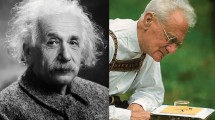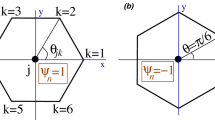Abstract
The absolute perfection with which honeybees construct their hexagonal comb cells has astonished human beings since ancient times. The deep mystery is not why hexagons, but how such a perfect geometrical shape is fabricated, without any geometrical portrait or tools. Do they possess divine intelligence? Recent studies shed light on this revered mystery and show beyond doubt that it is the thermo-mechanical properties of beeswax and the knitting mechanism of bees that remould fresh circular cells into rounded hexagonal shape. How does this remoulding happen? In this article, we describe the inner mechanism involved in such spontaneous transformation of shapes, and explore the hidden mystery behind honeybee’s architecture.
Similar content being viewed by others
Suggested Reading
R H Hepburn, Honeybees and Wax: An experimental natural history, Springer-Verlag, Berlin (1986).
H R Hepburn and S P Kurstjens, The combs of honeybees as composite materials, Apidologie, Vol.19, 25, 1988.
T C Hales, Cannonballs and honeycombs, Notices of the AMS, Vol.47, 440, 2000.
E G Klarreich, Foams and honeycombs, Am. Sci. 88, 152 (2000).
T C Hales, The honeycomb conjecture, Discrete Comput. Geom., Vol.25, PP.1–22, 2001.
George G Szpiro, Kepler’s Conjecture, John Wiley & Sons, New Jersey (2003).
R Buchwald, M D. Breed, and A R Greenberg, The thermal properties of beeswaxes: unexpected findings, J. Exp. Biol., Vol.211, No.121, 2008.
S P. Kurstjens, H R Hepburn, F R L Schoening and B C. Davidson, The conversion of wax scales into comb wax by African honeybees, J. Comp. Physiol. B, Vol.156, No.95, 1985.
D F Siemens Jr, Of bees and mathematicians, The Mathematics Teacher, Vol.60, PP.758–761, 1967.
B L Karihaloo, K Zhang and J Wang, Honeybee combs: how the circular cells transform into rounded hexagons, J. R. Soc. Interface, Vol.10, p.20130299, 2013.
F Nazzi, The hexagonal shape of the honeycomb cells depends on the construction behavior of bees, Sci. Rep., Vol.6, p.28341, 2016.
D Talukdar and K Dutta, A simplified thermomechanical approach to visualize hexagonal honeycomb construction, SN Applied Science, Vol.1, p.1220, 2019.
R Buchwald, A R Greenberg and M D Breed, A biomechanical perspective on beeswax, American Entomologist 51, 39, 2005.
K Zhang, H L Duan, B L Karihaloo and J Wang, Hierarchical, multilayered cell walls reinforced by recycled silk cocoons enhance the structural integrity of honeybee combs, Proc. Natl Acad. Sci., USA Vol.107, 9502, 2010.
C W W Pirk, H R Hepburn, S E Radloff and J Tautz, Honeybee combs: construction through a liquid equilibrium process? Naturwissenschaften, VVol.91, PP.350–353, 2004.
A P Tulloch, Beeswax — composition and analysis, Bee World, Vol.61, 47, 1980.
S P Kurstjens, E McClain, and H R Hepburn, The proteins of beeswax, Naturwissenschaften, Vol.77, 34, 1990.
R Buchwald, M D Breed, L Bjostad, B E Hibbard and A R Greenberg, The role of fatty acids in the mechanical properties of beeswax, Apidologie, Vol.40, 585, 2009.
S Sinaringati et al., The utilisation of paraffin and beeswax as heat energy storage in infant incubator, ARPN J. Eng. Appl. Sci., Vol.11, 800, 2016.
R G Craig, J D Eick and F A Peyton, Properties of natural waxes used in dentistry, J. dent. Res., Vol.44, 1308, 1965.
M E Hossain et al., Experimental studies on physical and mechanical properties of natural and synthetic waxes using uniaxial compressive strength test, Proc. ICCST’09, 41–44246, 2009.
R Buchwald, M D Breed, A R Greenberg and G Otis, Interspecific variation in beeswax as a biological construction material, J. Exp. Biol., Vol.209, p.3984, 2006.
M. Kleinhenz et al., Hot bees in empty broodnest cells: heating from within, J. Exp. Bio., Vol.206, 4217, 2003.
D Bauer and K Bienefeld, Hexagonal comb cells of honeybees are not produced via a liquid equilibrium process, Naturwissenschaften, Vol.100, 45, 2013.
Elmer web pages: http://www.csc.fi/elmer/.
R Hill, The Mathematical Theory of Plasticity, Clarendon Press, Oxford, 2004.
T H Shellhammer, T R Rimsey, and J M Krochta, Viscoelastic properties of edible lipids, J. Food Eng., Vol.33, 305, 1997.
Acknowledgement
The present article is published as a requirement of scientific social responsibility policy under the MATRICS scheme, granted by Science and Engineering Research Board (SERB), Govt. of India (Grant No. MTR/2019/000044).
Author information
Authors and Affiliations
Corresponding author
Additional information
Kishore Dutta is working in the Department of Physics, Handique Girls’ College, Guwahati. His research interests include nonlinear dynamics, critical phenomena in strongly correlated magnetic systems, quantitative social sciences, to name a few.
Rights and permissions
About this article
Cite this article
Dutta, K. Natural Hexagons. Reson 26, 399–413 (2021). https://doi.org/10.1007/s12045-021-1138-8
Published:
Issue Date:
DOI: https://doi.org/10.1007/s12045-021-1138-8




